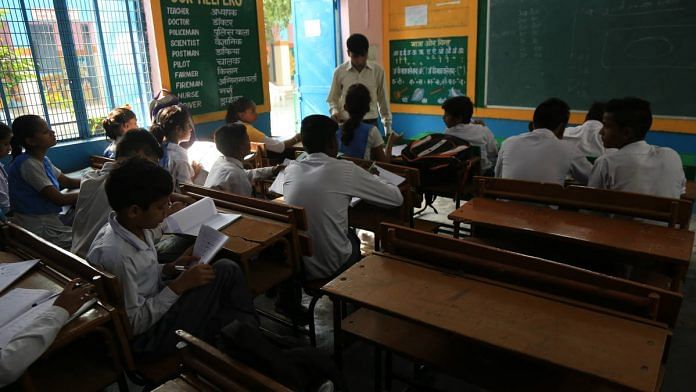New Delhi: Setting a four-hour play-based timetable in Anganwadis, and twinning them with nearby primary schools, identifying the three crore out-of-school children across the country by next year, and focusing on improving foundation literacy and numeracy — these are among the key Niti Aayog recommendations to states to improve education levels.
Delineating a roadmap for the National Education Policy (NEP), the federal think-tank made the suggestions in its report prepared before the Governing Council meeting chaired by Prime Minister Narendra Modi last week. ThePrint has accessed a copy of the report.
The Niti Aayog cited a survey conducted by the Ministry of Women and Child Development to argue that 27 per cent of the children in the age group 3-6 years don’t attend any pre-school education.
To fix this, it suggested setting a daily 4-hour play-based timetable in Anganwadis, which need to be twinned with nearby primary schools, starting from the academic year 2021-22.
It also called for local and contextualised teaching-learning material for students.
The report further said the Balvatika programme, which will involve developing a crèche in Anganwadis for young students, should begin this year itself. These Anganwadis will be co-located with a primary school.
The Niti Aayog also suggested preparing a 10-year roadmap of starting Balvatikas in every primary school with clear annual targets.
The report recommended setting up a joint task force of Department of School Education and Department of Women and Child Development in each state for this purpose.
The new NEP talks about early childhood education by integrating Anganwadis with primary schools. As of now, formal schooling in government schools starts with Class 1, but once the NEP gets implemented, young children at the age of 3-6 will also be a part of the formal education system.
Also read: Higher education evaluation must focus on skills, outcomes and not just marks, says UGC
Mainstreaming three crore out-of-school children
According to the report, there are over three crore out-of-school children across the country who must be brought within the ambit of education.
For this, the Niti Aayog recommended a household survey to be conducted this year to identify all the out-of-school children, and a 10-year projection of need analysis of infrastructure, residential schools, hostel requirements, etc. be undertaken to increase access to education.
Recognising the drop-out rate in the country, the report said, “The drop-out of 17.8 percent at the secondary stage is alarming.
“The U-DISE 2018-19 shows that the GER (Gross Enrolment Ratio) drops from 79.6 per cent at secondary level to 58.56 per cent at higher secondary level,” it said.
“This is the point where maximum students are dropping out. As a result, the pool of students for higher education also shrinks leading to a GER of only 26.3 per cent in higher education much below the world average of 37 per cent,” it added.
In a bid to ensure continuity in education at the secondary level, the agency recommended a slew of measures: Identifying high dropout prevalence districts in the state; starting vocational educational courses at secondary level in all such districts; and forming a 10-year roadmap with clear annual access targets at pre-primary, primary, elementary, secondary and higher secondary level so as to achieve 100 per cent GER in the state by 2030.
Also read: Govt will not hike M.Tech fee at IITs this year, plans incentives to check dropouts
‘Substantial gap in skilling’
While over five crore people have been trained under Skill India in the last five years, there remains a substantial gap in skilling in the country, the report noted.
Industrial Training Institutes (ITIs) are primary training institutions for delivering long-term vocational education and training, and the cornerstone of the government’s Skill India programme.
The report has underscored the “poor quality” of long-term skilling by these institutions.
Of the key challenges identified are instructor vacancies — against 1.23 lakh positions, only 64,000 are currently filled; of 64,000 instructors only 11,000 are formally trained; inadequate provisions for raw materials, teaching aids and instructors grants; ill-equipped IT labs and classrooms for smart learning; absence of new age trades/courses; and poor pass percentage.
Low female labour force participation — just over 12 per cent across the country — and low Persons with Disabilities Participation — only 0.8 per cent — have also been identified as challenges.
Also read: Graded autonomy to Board of Governors — IIT council forms 4 groups for NEP-related issues



